December 2008 Archives
A worldwide event each year is the prestigious Coin of the Year awards. This year two of our own coins have been nominated in the "people's choice" category. They are competing amongst other coin designs from China, Poland, Hungary, Germany, Canada, US, Austria, Russia, Japan, Denmark, France, The UK and Finland. Our own coins nominated are the 1oz $1 Koala from The Perth Mint and the 2009 Gold $25 Kangaroo at Sunset from The Royal Australian Mint. You can read about the very popular Kangaroo at Sunset Coin here in a previous post. This spectacular coin has secured my vote, to vote for your favorite or view the nominated coin designs please visit the numismaster website. You'll need to join up to vote but if you have any interest in world coins you'll know when I say that this site is powered by Krause it is 'the' site in the know about world coins. (Krause are the people behind the World Coin catalogues).
2009 marks the 400th anniversary of Galileo Galilei's first astronomical observation through a telescope. In celebrating the International year of Astronomy in 2009 the vision is to help people rediscover their place in the universe. To mark this occasion The Royal Australian Mint is theming their 2009 coin issues accordingly.
Available now is:
- the 2009 Six coin Proof set, the $1 coin design featuring the Parkes Radio Telescope. This set retails for $115 -note a price increase from the 2008 price of $95
- the 2009 Six coin Uncirculated set, the 20 cent coin featuring 3 star gazers sky-observing. This set retails for $30.
- the 2009 Two coin Proof set features the themed 20 cent and the mob of roos one dollar. This set retails for $45.
- the 2009 Two coin Uncirculated set features the themed one dollar and the regular designed platypus 20 cent. This set retails for $15.
Collectors have been waiting anxiously for the newly released sixteenth edition of the 2009 pocket guide to Australian Coins and Banknotes. It's author Greg McDonald has been working tirelessly to have the new edition out to it's readers before Christmas 2008. It is avaliable now from your nearest numismatic supplier or bookshop in paperback for $29.95. The "bible" of Australian numismatics or "Macca's" as it is affectionately termed has been lovingly updated annually by Greg since 1993.
The Macca's guide contains updated pricing information for Proclamation and Colonial coins, Gold coins, Australian pre-decimal and decimal coins, Royal Australian Mint and The Perth Mint issues, Internment camp tokens and pre-decimal and decimal banknotes. It contains information on grading, advice on buying and selling and an index of numismatic terms. There are also many advertisements from dealers which is a valuable asset when looking to sell coins or finding who to contact to obtain your next purchase.
The new book is smaller than the previous issue, around 40 pages lighter. This is difficult to fathom though as the new book contains many new issues, extra information and items previously overlooked from the pocketbook.
The 2009 Pocket Guide to Australian Coins and Banknotes by Greg McDonald -sixteenth edition is a must have for the serious collector so get out there and hassle your dealer or bookshop for a copy today!
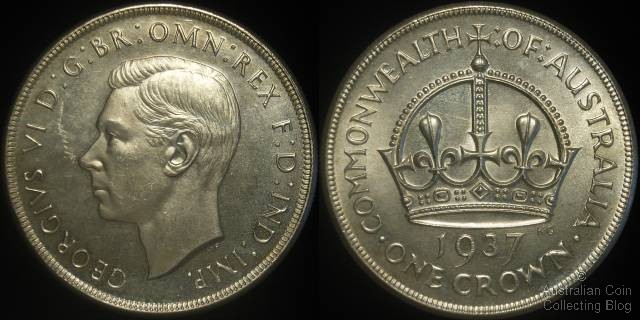
Australia 1937 Crown
The silver Australian Crown was minted in Melbourne only in the years 1937 and 1938. It depicts an image of a royal crown on the reverse designed by George Kruger Gray and George VI portrait on the obverse by Thomas H Paget. It's denomination is 5 shillings.
The Australian Crown was initially issued in 1937 to mark the occasion of the coronation of George VI. Many of these were hoarded as keepsakes of the occasion. Because of this popularity it was released again in 1938 but without much success. As a new denomination and a large coin weighing 28.27 grams with a 38.5 millimetre diameter it was considered too heavy and awkward to be carried for everyday usage. The 1937 crown has a mintage of 1 008 000 and the 1938 a mere 101 000 thus the 1938 is the rarer more sought after coin.
Because of the hoarding of the 1937 crown it is quite common to see these coins in mid-grade however rarely seen in the lowest grades and difficult to obtain in the highest grades. The highest point to note in the design when looking for wear is the cross in the orb of the crown and how distinguishable it is. Crowns are often found with heavy bagmarks because of the heavily reeded edge and the large fields.
A great way of communicating with others interested in numsmatics is via online forums. It's a valuable resource to keep up to date with new mint releases, variety finds, items of interest from circulation, eBay or online auction items and pricing and making friends and having a general chat.
There are a few major forums on the internet that you can join and post questions and get answers even if you don't collect and just want information about your own collection or inheritance.
Most forums have sub-forums and then threads for the many different facets involved in collecting. Sub-forum's for Australian coins, US coins, Banknotes, Tokens, PNC's, Ancient Coins, Grading and Trading are among the many topics discussed.
The major forum frequented by Australian collectors and those interested in Australian issues is The Australian Coin Forum. Interesting discussions and information can also be found on the Coin Community Forum (CCF), Cointalk and the PCGS Forum.
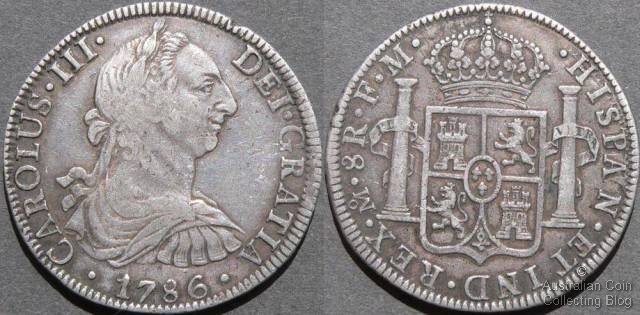
Spain 1786 8 Reale Mexico Mint - Die Clash on Shield Side
The die clash (or clashed dies) coin error occurs when the obverse and reverse dies impact with each other without a coin blank or planchet between the dies. The result of this is that the obverse die leaves an impression on the reverse die and the reverse leaves an impression on the obverse die. When a coin is struck with these damaged dies the result is a partial incuse image of the other die on the coin. For example, in the 8 reales coin shown above, there is a strong die clash on the shield side of the coin from about 12 o'clock to 3 o'clock near the rim.
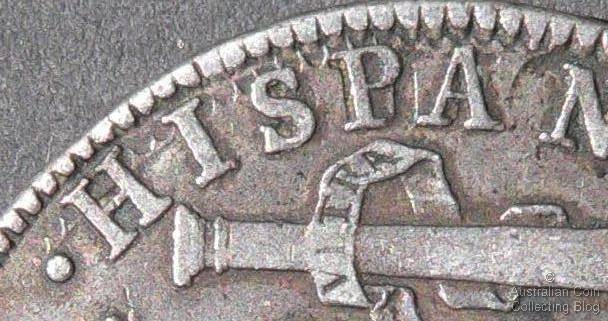
Spain 1786 8 Reale Mexico Mint Clash Detail
You can see here incuse rim denticles from the portrait side under the normal shield side design. You can also see incuse mirrored letters from the portrait side. In this case the design is opposite the portrait legend 'CAROLUS III'. If you look carefully you can see an incuse U under the P of HISPAN, a L under the A, and an O between the A and the N.
Die clashes are not particularly unusual nor are they a visually spectacular type of coin error. However, because of their nature they are more of a variety than an error and can be an interesting method of building a collection. The degree of the clash adds to the interest of the coin, obviously larger clashes are more visually appealing coins, but smaller clashes can be an interesting item to look for when searching bulk lots.
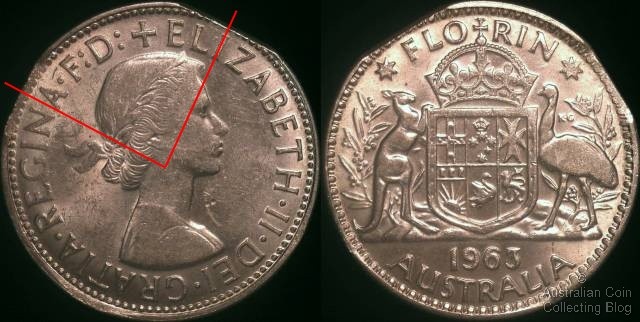
Australia 1963 Florin Double Straight Clip Coin Error
A couple of entries back I talked about the Double Straight Clip Coin Error. I've been lucky enough to purchase one of these lately and you can see an image of it above. It's a 1963 Australian Florin which shows two good sized clips. The red lines illustrate how the clips are 90 degrees apart.
When I was purchasing the foam ring insert type Airtites to house my coins I found that the sizes stated were all for US coins. They are only available to buy from America so this is understandable. I am in Australia and wanted to store my coins in these Airtite coin capsules so I had to do some research to determine which sizes fit best for Aussie coins. These are the results of my study:
- Halfpenny -T 25
- Penny -H 30
- Threepence- A 16
- Sixpence- A 19
- Shilling -T 23
- Florin -H 28
- Crown- I 38
- One cent- A 17
- Two cent -T 21
- 5c -A 19
- 10c -T 23
- 20c- H 28
- 50c -H 31
- $1 -T 24
- $2 -T 20
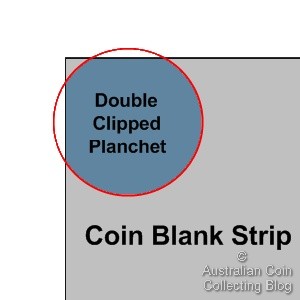
How a Double Straight Clip Might Be Made
An interesting variation on the straight clip coin error is the double straight clip coin error. You may remember that a straight clip occurs when a coin blank is punched out overlapping the end or one of the edges of the metal strip that the coin blanks are punched from. I've been lucky enough lately to obtain a double straight clipped error coin (pictures to follow in the next few days). On this coin the straight clips are exactly 90 degrees rotated from each other.
If you take a look at the picture above you can see how this error would have occured. The coin blank is punched out from the corner of the metal coining strip and is missing two segments. Because it was punched out from the edge of the strip straight clips resulted, and because it was in the corner the clips are 90 degrees rotated from each other.
An interesting error to look out for and not often seen. I feel they are worth picking up when they are found!
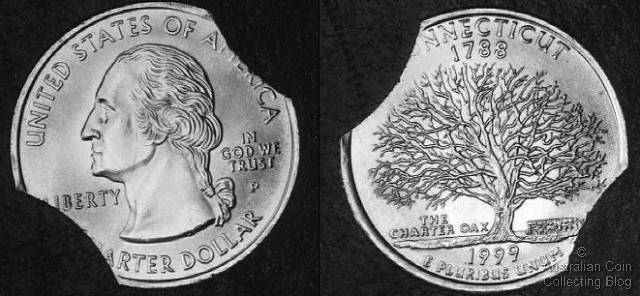
USA Connecticut 25 cent Double Curved Clip Coin Error
As a follow on to the entries about clipped planchet coin errors I've decided to put up a post on the double curved clip coin error. You can see an example of this sort of coin error above. This 1999 Connecticut state quarter exhibits two distinct curved planchet clips at 180 degrees from each other. These errors are a lot more unusual than the single curved clip coin errors and for some denominations from some countries are almost non existent. I've only seen two Australian pre-decimal double clip errors in two years! Given their scarcity I feel they are an undervalued error and I'd recommend picking them up where you can.
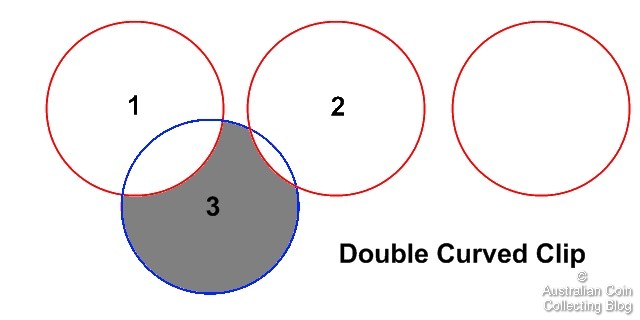
How Double Curved Clips Are Made
To give you an idea of how these errors occur please take a look at the diagram above. Typically coin blanks are punched from a metal strip in rows. The rows are usually offset from each other (like the courses of bricks on a house) to more fully utilize the metal in the strip. In the example above the first row of blanks has been punched out correctly. However, for due to some material feeding fault or machine error the metal strip has moved from where it should have been punched so that coin blank 3 is punched out of an area that already had coin blanks 1 and 2 punched from it. This results in 2 curved clips on coin blank 3.
There are many variations on this sort of clip. The picture of the USA State Quarter above suggests that 3 coin blanks overlapped on the same row of the metal strip as the curved clips are 180 degrees apart.
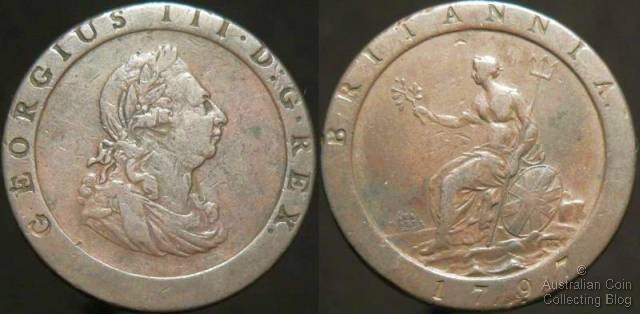
Proclamation 1797 Cartwheel Penny
In my previous entry about Australian proclamation coins I mentioned the 1797 cartwheel penny of Great Britain which was valued at 2d in the proclamation. These large (36 millimetre diameter) copper coins were struck in copper in the years 1797 to 1799. Their large distinctive raised rims were reminiscent of cartwheels and they were nicknamed accordingly. The cartwheel penny and twopence were the first coins minted anywhere in the world using steam powered coin presses, and this new technology allowed the mass production of a well struck yet very large coin. The coins themselves weighed exactly 1 ounce (avoirdupois) or 28.35g. This was intentional and allowed the coins (and their 2 penny brethren which weighed 2 oz) to be used as weights for scales.
The coins were minted at the Soho mint (the mint mark is visible on the reverse) in Birmingham. The mint itself was setup by Matthew Boulton, the well known 18th factory owner and manufacturer. His mint used steam powered coin presses, with the steam engines designed and manufactured with his business partner and steam engine pioneer James Watt.
The obverse of the coin depicts a laureate bust of King George III facing right. The unusual incuse legend in the cartwheel rim reads Georgius III D.G. REX. This translates to George III, by the grace of God, King.
The reverse of the coin depicts robed and seated Britannia facing left holding a trident. She is depicted on a back drop of the ocean with a ship at the bottom left, this symbolized Britains naval might and reliance on sea trade at the time of the striking of the coins. The mint mark SOHO can be seen in small incuse letters just below the figure of Britannia in the exergue. The incuse legend in the rims reads Britannia 1797.
A key problem with purchasing these coins is the sheer size and weight of the coin. This can lead to significant rim bruising that (if possible) should be avoided when purchasing a coin. That being said attractive mid grade coins are readily available at reasonable cost. Higher grade coins (extremely fine and above) are obtainable if you are willing to wait for a coin to appear. Interestingly proof specimens of the cartwheel penny are available in straight copper, gilded, and bronzed copper. These are stunningly attractive coins but priced accordingly!
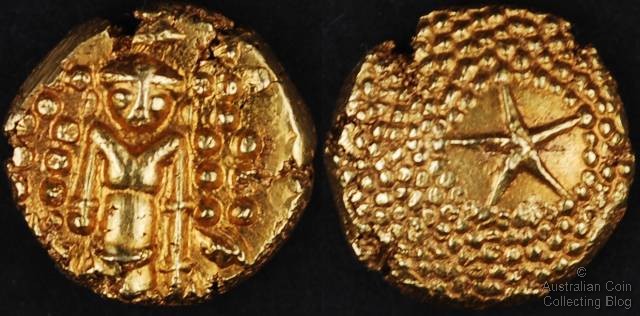
Indian Proclamation Star Pagoda
In my previous entry about Australian proclamation coins I mentioned the gold pagoda of India which was valued at 8s in the proclamation. These small gold coins were a standard gold coin in southern India from the late 16th century. India, at the time, comprised a number of separate kingdoms, some of which were self governing and others which were ruled by the British, French, and the Dutch. The gold pagoda coins were, in fact, minted by the colonial powers in India rather than by the India itself. It is commonly accepted that the gold pagoda mentioned in the proclamation was that minted by the British East India company from 1740 to 1807 as the British link ensured that the coins found their way to many of the English colonies.
The gold pagodas were minted using the ancient hammering technique. Basically small discs or blobs of gold of the correct mass were placed on a reverse die, and the obverse die (the so called hammer die) hammered into the blank coin producing the design. This results in an iregularly shaped coin that can often be weakly struck and the flan can show cracks along the edge. There were two types of gold pagoda coins struck by the East India company. The more commonly found single figure 'star' pagoda is about 11 millimetres in diameter and contained 3.41 grams of 82.3% pure gold. The less common 3 figure pagoda is slightly larger at 12-14 millimetres but contains almost the same amount of gold.
The obverse design of the gold pagoda coins were inspired by coins from the Vijayanagar Empire which ruled southern India before the English. The single figure star pagoda depicts the Indian god, Lord Vishnu. The three figure pagoda depicts the same Indian god, Lord Vishnu flanked by his consorts Sridevi and Budevi. The designs themselves are crude and suited to the manufacturing method of the coin.
Both the single figure star pagoda and the three figure pagoda display a granulated or beaded reverse. However, the 'star' pagoda includes a five pointed star giving this coin it's name.
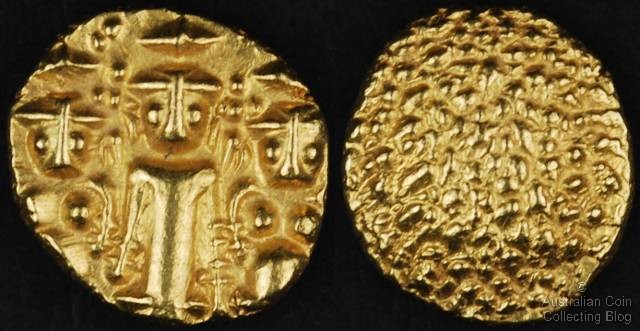
Indian Proclamation Three Figure Pagoda Madras Mint 1740-1807AD
When looking to purchase a gold pagoda I would look for the best coin affordable with eye appeal. The hammered manufacturing technique means that flan cracks are common so I'd look for a coin with minimal or non distracting cracks. As to whether you should obtain a star pagoda or the three figure coin I'd probably suggest the star pagoda. These are the coins pictured in the Australian coin catalogue 'McDonalds' and were probably more commonly available. However, the three figure pagodas are larger and have more design elements and I find them more attractive. Of course, finances permitting, I'd probably suggest getting both varieties!


